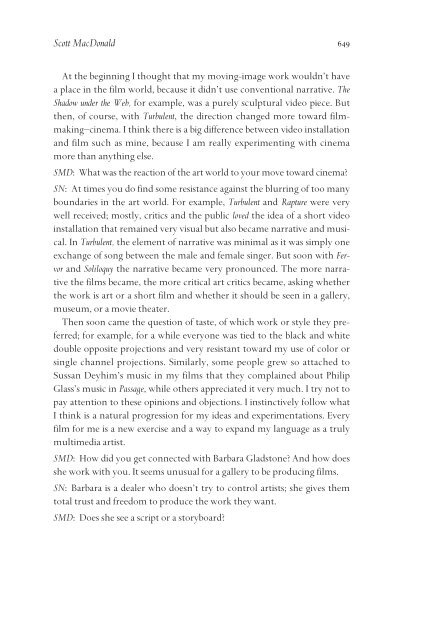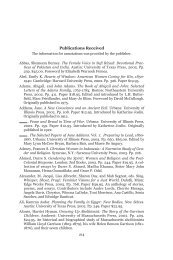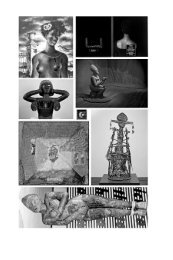An Interview with Shirin Neshat - Feminist Studies
An Interview with Shirin Neshat - Feminist Studies
An Interview with Shirin Neshat - Feminist Studies
Create successful ePaper yourself
Turn your PDF publications into a flip-book with our unique Google optimized e-Paper software.
Scott MacDonald 649<br />
At the beginning I thought that my moving-image work wouldn’t have<br />
a place in the film world, because it didn’t use conventional narrative. The<br />
Shadow under the Web, for example, was a purely sculptural video piece. But<br />
then, of course, <strong>with</strong> Turbulent, the direction changed more toward filmmaking–cinema.<br />
I think there is a big difference between video installation<br />
and film such as mine, because I am really experimenting <strong>with</strong> cinema<br />
more than anything else.<br />
SMD: What was the reaction of the art world to your move toward cinema?<br />
SN: At times you do find some resistance against the blurring of too many<br />
boundaries in the art world. For example, Turbulent and Rapture were very<br />
well received; mostly, critics and the public loved the idea of a short video<br />
installation that remained very visual but also became narrative and musical.<br />
In Turbulent, the element of narrative was minimal as it was simply one<br />
exchange of song between the male and female singer. But soon <strong>with</strong> Fervor<br />
and Soliloquy the narrative became very pronounced. The more narrative<br />
the films became, the more critical art critics became, asking whether<br />
the work is art or a short film and whether it should be seen in a gallery,<br />
museum, or a movie theater.<br />
Then soon came the question of taste, of which work or style they preferred;<br />
for example, for a while everyone was tied to the black and white<br />
double opposite projections and very resistant toward my use of color or<br />
single channel projections. Similarly, some people grew so attached to<br />
Sussan Deyhim’s music in my films that they complained about Philip<br />
Glass’s music in Passage, while others appreciated it very much. I try not to<br />
pay attention to these opinions and objections. I instinctively follow what<br />
I think is a natural progression for my ideas and experimentations. Every<br />
film for me is a new exercise and a way to expand my language as a truly<br />
multimedia artist.<br />
SMD: How did you get connected <strong>with</strong> Barbara Gladstone? <strong>An</strong>d how does<br />
she work <strong>with</strong> you. It seems unusual for a gallery to be producing films.<br />
SN: Barbara is a dealer who doesn’t try to control artists; she gives them<br />
total trust and freedom to produce the work they want.<br />
SMD: Does she see a script or a storyboard?




